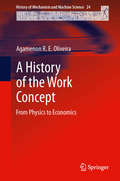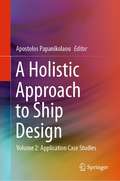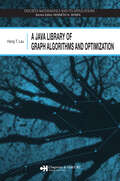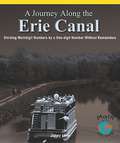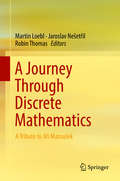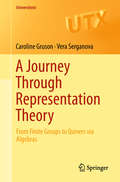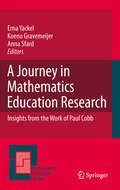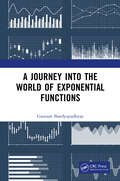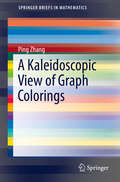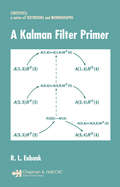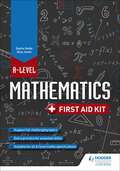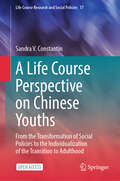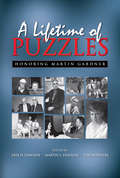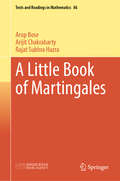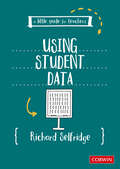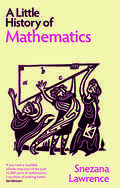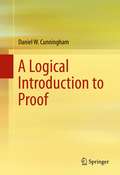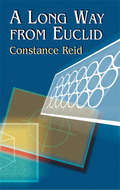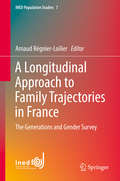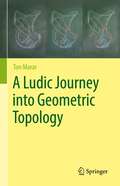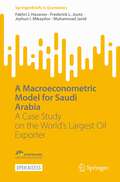- Table View
- List View
A History of the Work Concept: From Physics to Economics (History of Mechanism and Machine Science #24)
by Agamenon R. E. OliveiraThis book traces the history of the concept of work from its earliest stages and shows that its further formalization leads to equilibrium principle and to the principle of virtual works, and so pointing the way ahead for future research and applications. The idea that something remains constant in a machine operation is very old and has been expressed by many mathematicians and philosophers such as, for instance, Aristotle. Thus, a concept of energy developed. Another important idea in machine operation is Archimedes' lever principle. In modern times the concept of work is analyzed in the context of applied mechanics mainly in Lazare Carnot mechanics and the mechanics of the new generation of polytechnical engineers like Navier, Coriolis and Poncelet. In this context the word "work" is finally adopted. These engineers are also responsible for the incorporation of the concept of work into the discipline of economics when they endeavoured to combine the study of the work of machines and men together.
A Holistic Approach to Ship Design: Volume 2: Application Case Studies
by Apostolos PapanikolaouThis book deals with modern Computer-Aided Design (CAD) software tools and platforms implemented in ship design, the integration of techno-economic databases, the use of optimisation and simulation software tools, which are integrated in these platforms, and the virtual modelling of ships and their operation by using a Virtual Vessel Framework (VVF). It contains a series of application case studies related to the developed holistic approach to ship design and operation. Nine case studies are described, referring to the design and operation of various ship types, namely RoPax, cruise ship, double-ended ferry, bulk carrier, containership, offshore support vessel, ocean surveillance ship and research vessel and one offshore structure. All case studies are driven by leading representatives of the European Maritime Industry. This book complements A Holistic Approach to Ship Design, volume 1, which covers methods and tools for the life cycle optimisation and assessment of ship design and operation.
A Java Library of Graph Algorithms and Optimization (Discrete Mathematics and Its Applications)
by Hang T. LauBecause of its portability and platform-independence, Java is the ideal computer programming language to use when working on graph algorithms and other mathematical programming problems. Collecting some of the most popular graph algorithms and optimization procedures, A Java Library of Graph Algorithms and Optimization provides the source code for
A Journey Along The Erie Canal: Dividing Multidigit Numbers By A One-digit Number Without Remainders
by Janey LevyThis fascinating paperback describes the construction and history of the Erie Canal. It uses the information to illustrate elementary division. Includes a scanned photocopy of a weekly toll collection statement from 1860.
A Journey Through Discrete Mathematics: A Tribute To Ji I Matou Ek
by Jaroslav Nešetřil Martin Loebl Robin ThomasThis collection of high-quality articles in the field of combinatorics, geometry, algebraic topology and theoretical computer science is a tribute to Jiř#65533; Matousek, who passed away prematurely in March 2015. It is a collaborative effort by his colleagues and friends, who have paid particular attention to clarity of exposition - something Jirka would have approved of. The original research articles, surveys and expository articles, written by leading experts in their respective fields, map Jiř#65533; Matousek's numerous areas of mathematical interest.
A Journey Through Representation Theory: From Finite Groups to Quivers via Algebras (Universitext)
by Caroline Gruson Vera SerganovaThis text covers a variety of topics in representation theory and is intended for graduate students and more advanced researchers who are interested in the field. The book begins with classical representation theory of finite groups over complex numbers and ends with results on representation theory of quivers. The text includes in particular infinite-dimensional unitary representations for abelian groups, Heisenberg groups and SL(2), and representation theory of finite-dimensional algebras. The last chapter is devoted to some applications of quivers, including Harish-Chandra modules for SL(2). Ample examples are provided and some are revisited with a different approach when new methods are introduced, leading to deeper results. Exercises are spread throughout each chapter. Prerequisites include an advanced course in linear algebra that covers Jordan normal forms and tensor products as well as basic results on groups and rings.
A Journey in Mathematics Education Research: Insights from the Work of Paul Cobb (Mathematics Education Library #48)
by Anna Sfard Paul Cobb Erna Yackel Koeno GravemeijerOur objective is to publish a book that lays out the theoretical constructs and research methodologies within mathematics education that have been developed by Paul Cobb and explains the process of their development. We propose to do so by including papers in which Cobb introduced new theoretical perspectives and methodologies into the literature, each preceded by a substantive accompanying introductory paper that explains the motivation/rationale for developing the new perspectives and/or methodologies and the processes through which they were developed, and Cobb's own retrospective comments. In this way the book provides the reader with heretofore unpublished material that lays out in considerable detail the issues and problems that Cobb has confronted in his work, that, from his viewpoint, required theoretical and methodological shifts/advances and provides insight into how he has achieved the shifts/advances. The result will be a volume that, in addition to explaining Cobb's contributions to the field of mathematics education, also provides the reader with insight into what is involved in developing an aggressive and evolving research program. When Cobb confronts problems and issues in his work that cannot be addressed using his existing theories and frameworks, he looks to other fields for theoretical inspiration. A critical feature of Cobb's work is that in doing so, he consciously appropriates and adapts ideas from these other fields to the purpose of supporting processes of learning and teaching mathematics; He does not simply accept the goals or motives of those fields. As a result, Cobb reconceptualizes and reframes issues and concepts so that they result in new ways of investigating, exploring, and explaining phenomena that he encounters in the practical dimensions of his work, which include working in classrooms, with teachers, and with school systems. The effect is that the field of mathematics education is altered. Other researchers have found his "new ways of looking" useful to them. And they, in turn, adapt these ideas for their own use. The complexity of many of the ideas that Cobb has introduced into the field of mathematics education can lead to a multiplicity of interpretations by practitioners and by other researchers, based on their own experiential backgrounds. Therefore, by detailing the development of Cobb's work, including the tensions involved in coming to grips with and reconciling apparently contrasting perspectives, the book will shed additional light on the processes of reconceptualization and thus help the reader to understand the reasons, mechanisms, and outcomes of researchers' constant pursuit of new insights.
A Journey into Modern Physics: From Relativity to Quantum Technologies
by Carmine GranataThis book offers a short journey into the surprising and spectacular world of modern physics characterized by disruptive ideas and theory from both a conceptual and applicative point of view. Starting from Einstein's theory of relativity in which the concepts of space, time, and gravity are completely revised, before arriving at the bizarre and fascinating universe of quantum physics which with its applications has completely changed our way of life. Particular attention is also paid to the conceptual foundations and paradoxes of quantum mechanics thanks to which the so-called second quantum revolution has developed in more recent times, destined to introduce a new generation of quantum technologies such as computers, cryptography, and teleportation into our lives. In addition to new quantum technologies, the operating principles of the most important applications of quantum mechanics which have become widespread in everyday life are illustrated simply and concisely. The book has an essentially informative character, without making use of complicated formulas or technicalities, therefore it does not require in-depth knowledge of physics or mathematics; the knowledge acquired in high school is sufficient to understand the topics covered.
A Journey into the World of Exponential Functions
by Gautam BandyopadhyayThe number e, the function ex, the logarithmic function in (x) and different hyperbolic functions like cosh (x), sinh (x) make frequent appearances in science and engineering textbooks. Students often fail to appreciate the significance of these mathematical symbols. This book clearly illustrates why such abstract mathematical entities are needed to represent some aspects of physical reality. It provides an overview of different types of numbers and functions along with their historical background and applications. It contains four chapters covering number system, exponential function, logarithmic functions and hyperbolic functions along with the concept of complex angle. Print edition not for sale in South Asia (India, Sri Lanka, Nepal, Bangladesh, Pakistan or Bhutan)
A Kaleidoscopic View of Graph Colorings (SpringerBriefs in Mathematics)
by Ping ZhangThis book describes kaleidoscopic topics that have developedin the area of graph colorings. Unifying current material on graph coloring,this book describes current information on vertex and edge colorings in graphtheory, including harmonious colorings, majestic colorings, kaleidoscopiccolorings and binomial colorings. Recently there have been a number of breakthroughs in vertex coloringsthat give rise to other colorings in a graph, such as graceful labelings ofgraphs that have been reconsidered under the language of colorings. The topics presented in this book include sample detailedproofs and illustrations, which depicts elements that are often overlooked. This book is ideal for graduate students and researchers in graph theory, as itcovers a broad range of topics and makes connections between recentdevelopments and well-known areas in graph theory.
A Kalman Filter Primer
by Randall L. EubankSystem state estimation in the presence of noise is critical for control systems, signal processing, and many other applications in a variety of fields. Developed decades ago, the Kalman filter remains an important, powerful tool for estimating the variables in a system in the presence of noise. However, when inundated with theory and vast notation
A Kinetic View of Statistical Physics
by Pavel L. Krapivsky Sidney Redner Eli Ben-NaimAimed at graduate students, this book explores some of the core phenomena in non-equilibrium statistical physics. It focuses on the development and application of theoretical methods to help students develop their problem-solving skills. The book begins with microscopic transport processes: diffusion, collision-driven phenomena, and exclusion. It then presents the kinetics of aggregation, fragmentation and adsorption, where the basic phenomenology and solution techniques are emphasized. The following chapters cover kinetic spin systems, both from a discrete and a continuum perspective, the role of disorder in non-equilibrium processes, hysteresis from the non-equilibrium perspective, the kinetics of chemical reactions, and the properties of complex networks. The book contains 200 exercises to test students' understanding of the subject. A link to a website hosted by the authors, containing supplementary material including solutions to some of the exercises, can be found at www. cambridge. org/9780521851039.
A Learner’s Guide to Fuzzy Logic Systems, Second Edition
by K SundareswaranThis book presents an introductory coverage of fuzzy logic, including basic principles from an interdisciplinary perspective. It includes concept of evolving a fuzzy set and fuzzy set operations, fuzzification rule base design and defuzzification and simple guidelines for fuzzy sets design and selected applications. Preliminary concepts of Neural Networks and Genetic Algorithm are added features with relevant examples and exercises. It is primarily intended for undergraduate and postgraduate students and researchers to facilitate education in the ever-increasing field of fuzzy logic as medium between human intelligence and machine.
A Level Mathematics: First Aid Kit
by Sophie Goldie Rose JewellMaster essential skills and boost progress in A-level Maths with extra support and practice for every topic. This book provides structured guidance through clear explanations, worked examples and practice questions.- Improve understanding with clear explanations, worked examples and links that highlight relationships between topics- Put skills into practice and check understanding with skills-focused and problem-solving questions, plus carefully structured multiple-choice questions with detailed answers online that explain each correct and incorrect answer- Build confidence and develop awareness of potential misconceptions with 'Be the examiner' exercises- Learn to apply GCSE knowledge to A-level concepts with questions that bridge the gap between Key Stages 4 and 5- Identify and avoid common mistakes with worked solutions in the back of the book- Develop advanced calculator skills with links to extra online material designed to enhance understanding and develop checking strategies using a graphical calculator
A Life Course Perspective on Chinese Youths: From the Transformation of Social Policies to the Individualization of the Transition to Adulthood (Life Course Research and Social Policies #17)
by Sandra V. ConstantinThis open access book investigates from a life-course perspective the individualization process and the challenges faced by young adults in post-collectivist China, where people are enjoined to "liberate" (jiefang) their individual capacities, to "rely on themselves" (kao ziji) and to no longer "depend on the state" (kao guojia). Based on unique quantitative and qualitative data, this book provides a solid empirical portrait of Chinese youths and transformation of social policies in post-collectivist ChinaThis book will be a great resource to students, academics as well as social scientists and policy-makers who wish not only to understand how, in such a short period of time, young adults and their families have managed to navigate from a relatively egalitarian society to one of the most unequal, but also how the articulation between socialist and neoliberal ideologies is reconfiguring social and economic relations as well as women’s and men’s life-course.The basis of the English translation of this book from its French original manuscript was done with the help of artificial intelligence. A subsequent human revision and rewriting of the content was done by the author.
A Lifetime of Puzzles
by Erik D. Demaine Martin L. Demaine Tom RodgersMartin Gardner has entertained the world with his puzzles for decades and inspired countless mathematicians and scientists. As he rounds out another decade, his colleagues are paying him tribute with this special collection that contains contributions from some of the most respected puzzlemasters, magicians and mathematicians, including: - John H. Conway - William R. Gosper - Ed Pegg, Jr. - Roger Penrose - Raymond Smullyan - Peter Winkler. And of course there is something from the original puzzlemaster himself, Martin Gardner.
A Little Book of Martingales (Texts and Readings in Mathematics #86)
by Arup Bose Arijit Chakrabarty Rajat Subhra HazraThis concise textbook, fashioned along the syllabus for master’s and Ph.D. programmes, covers basic results on discrete-time martingales and applications. It includes additional interesting and useful topics, providing the ability to move beyond. Adequate details are provided with exercises within the text and at the end of chapters. Basic results include Doob’s optional sampling theorem, Wald identities, Doob’s maximal inequality, upcrossing lemma, time-reversed martingales, a variety of convergence results and a limited discussion of the Burkholder inequalities. Applications include the 0-1 laws of Kolmogorov and Hewitt–Savage, the strong laws for U-statistics and exchangeable sequences, De Finetti’s theorem for exchangeable sequences and Kakutani’s theorem for product martingales. A simple central limit theorem for martingales is proven and applied to a basic urn model, the trace of a random matrix and Markov chains. Additional topics include forward martingale representation for U-statistics, conditional Borel–Cantelli lemma, Azuma–Hoeffding inequality, conditional three series theorem, strong law for martingales and the Kesten–Stigum theorem for a simple branching process. The prerequisite for this course is a first course in measure theoretic probability. The book recollects its essential concepts and results, mostly without proof, but full details have been provided for the Radon–Nikodym theorem and the concept of conditional expectation.
A Little Guide for Teachers: Using Student Data (A Little Guide for Teachers)
by Richard SelfridgeStudent data can be one of the most powerful tools a teacher can use to help their students to learn. In this book, Richard Selfridge offers practical advice for teachers on how to gather useful student data in the classroom and how to use these findings effectively to enhance your teaching. The Little Guide for Teachers series is little in size but BIG on all the support and inspiration you need to navigate your day-to-day life as a teacher. Authored by experts in the field Easy to dip in-and-out of Interactive activities encourage you to write into the book and make it your own Read in an afternoon or take as long as you like with it!
A Little Guide for Teachers: Using Student Data (A Little Guide for Teachers)
by Richard SelfridgeStudent data can be one of the most powerful tools a teacher can use to help their students to learn. In this book, Richard Selfridge offers practical advice for teachers on how to gather useful student data in the classroom and how to use these findings effectively to enhance your teaching. The Little Guide for Teachers series is little in size but BIG on all the support and inspiration you need to navigate your day-to-day life as a teacher. Authored by experts in the field Easy to dip in-and-out of Interactive activities encourage you to write into the book and make it your own Read in an afternoon or take as long as you like with it!
A Little History of Mathematics (Little Histories)
by Snezana LawrenceA lively, accessible history of mathematics throughout the ages and across the globe Mathematics is fundamental to our daily lives. Science, computing, economics—all aspects of modern life rely on some kind of maths. But how did our ancestors think about numbers? How did they use mathematics to explain and understand the world around them? Where do numbers even come from? In this Little History, Snezana Lawrence traces the fascinating history of mathematics, from the Egyptians and Babylonians to Renaissance masters and enigma codebreakers. Like literature, music, or philosophy, mathematics has a rich history of breakthroughs, creativity and experimentation. And its story is a global one. We see Chinese Mathematical Art from 200 BCE, the invention of algebra in Baghdad&’s House of Wisdom, and sangaku geometrical theorems at Japanese shrines. Lawrence goes beyond the familiar names of Newton and Pascal, exploring the prominent role women have played in the history of maths, including Emmy Noether and Maryam Mirzakhani.
A Logical Introduction to Proof
by Daniel W. CunninghamThe book is intended for students who want to learn how to prove theorems and be better prepared for the rigors required in more advance mathematics. One of the key components in this textbook is the development of a methodology to lay bare the structure underpinning the construction of a proof, much as diagramming a sentence lays bare its grammatical structure. Diagramming a proof is a way of presenting the relationships between the various parts of a proof. A proof diagram provides a tool for showing students how to write correct mathematical proofs.
A Long Way from Euclid
by Constance ReidMathematics has come a long way indeed in the last 2,000 years, and this guide to modern mathematics traces the fascinating path from Euclid's Elements to contemporary concepts. No background beyond elementary algebra and plane geometry is necessary to understand and appreciate author Constance Reid's simple, direct explanations of the arithmetic of the infinite, the paradoxes of point sets, the "knotty" problems of topology, and "truth tables" of symbolic logic. Reid illustrates the ways in which the quandaries that arose from unsolvable problems promoted new ideas. Numerical concepts expanded to accommodate such concepts as zero, irrational numbers, negative numbers, imaginary numbers, and infinite numbers.Geometry advanced into the widening territories of projective geometry, non-Euclidean geometries, the geometry of n-dimensions, and topology or "rubber sheet" geometry. More than 80 drawings, integrated with the text, assist in cultivating a grasp of the abstract foundations of modern mathematics, the search for truly consistent assumptions, the recognition that absolute consistency is unattainable, and the realization that some problems can never be solved.
A Longitudinal Approach to Family Trajectories in France
by Arnaud Régnier-LoilierAdopting a longitudinal approach, this book examines the dynamics of union and family formation in France and its effects on various aspects of life, such as employment, intergenerational transfers, etc. Drawing on data from a survey in which the same respondents were interviewed three times at three-year intervals, the book explores how demographic behaviours are influenced across the life course at individual level and assesses some of their consequences. The contributors give a clear understanding of how family behaviours are constructed and redefined. They track changes in respondents’ lives in order to pinpoint the factors that prevent couples from realizing their fertility intentions, for example, or to identify certain determinants of union formation or dissolution. They also provide a more detailed picture of the changes that shape family behaviours, such as the impact of a birth on the working career or on intergenerational support, and much more. Using longitudinal data from the French version of the Generations and Gender Survey (GGS), this book addresses family and childbearing behaviours dynamically, as processes that interact with each other and with the other components of each individual's life course.
A Ludic Journey into Geometric Topology
by Ton MararThis book draws on elements from everyday life, architecture, and the arts to provide the reader with elementary notions of geometric topology. Pac Man, subway maps, and architectural blueprints are the starting point for exploring how knowledge about geometry and, more specifically, topology has been consolidated over time, offering a learning journey that is both dense and enjoyable. The text begins with a discussion of mathematical models, moving on to Platonic and Keplerian theories that explain the Cosmos. Geometry from Felix Klein's point of view is then presented, paving the way to an introduction to topology. The final chapters present the concepts of closed, orientable, and non-orientable surfaces, as well as hypersurface models. Adopting a style that is both rigorous and accessible, this book will appeal to a broad audience, from curious students and researchers in various areas of knowledge to everyone who feels instigated by the power of mathematics in representing our world - and beyond.
A Macroeconometric Model for Saudi Arabia: A Case Study on the World’s Largest Oil Exporter (SpringerBriefs in Economics)
by Fakhri J. Hasanov Frederick L. Joutz Jeyhun I. Mikayilov Muhammad JavidThis Open Access Brief presents the KAPSARC Global Energy Macroeconometric Model (KGEMM). KGEMM is a policy analysis tool for examining the impacts of domestic policy measures and global economic and energy shocks on the Kingdom of Saudi Arabia. The model has eight blocks (real sector, fiscal, monetary, external sector, price, labor and wages, energy, population, and age cohorts) that interact with each other to represent the Kingdom’s macroeconomy and energy linkages. It captures New Keynesian demand-side features anchored to medium-run equilibrium and long-run aggregate supply. It applies a cointegration and equilibrium correction modeling (ECM) methodology to time series data to estimate the model’s behavioral equations in the framework of Autometrics, a general-to-specific econometric modeling strategy. Hence, the model combines ‘theory-driven’ approach with ‘data-driven’ approach. The Brief begins with an introduction to the theoretical framework of the model and the KGEMM methodology and then walks the reader through the structure of the model and its behavioral equations. The book closes with simulations showing the application of the model. Providing a detailed introduction to a cutting-edge, robust predictive model, this Brief will be of great use to researchers and policymakers interested in macroeconomics, energy economics, econometrics, and more specifically, the economy of Saudi Arabia.
